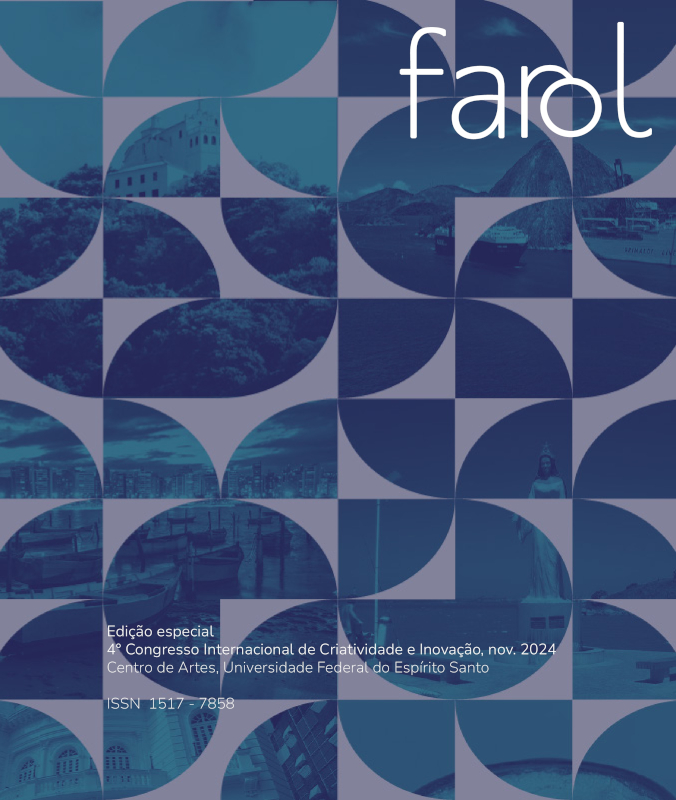Créativité et innovation 4.0. promouvoir le renouveau en réfléchissant aux possibilités
Mots-clés :
criatividade, inovação, pensamento de possibilidadesRésumé
Cet article explore les liens entre la créativité, l'innovation et la citoyenneté moderne, en se concentrant sur « Créativité et innovation 4.0 » pour comprendre comment ces dimensions contribuent aux progrès technologiques et remodèlent les normes sociales. Le travail aborde également les défis et les limites de la pensée des possibilités, y compris les inégalités technologiques. Enfin, l'article trace la voie vers une société dans laquelle la créativité et l'innovation servent non seulement le développement économique, mais aussi l'enrichissement de la vie démocratique.
Téléchargements
Références
APPADURAI, A. The Future as Cultural Fact: Essays on the Global Condition. Rassegna Italiana di Sociologia, Rivista Trimestrale Fondata da Camillo Pellizzi, 2013.
BAKHTIN, M. M. Problems of Dostoevsky's Poetics. Edited and translated by Caryl Emerson. University of Minnesota Press, 1984.
BARBOT, B.; KAUFMAN, J. C. What makes immersive virtual reality the ultimate empathy machine? Computers in Human Behavior, v. 111, Article 106431, 2020.
BEGHETTO, R. A.; GLĂVEANU, V. P. The beautiful risk of moving toward pedagogies of the possible. In: The Palgrave Handbook of Transformational Giftedness for Education. Springer, 2022. p. 23-42.
BRUCE, D. D.; CROOK, G. The Dream Cafe: Lessons in the Art of Radical Innovation. Wiley, 2015.
CHRISTENSEN, C. M.; RAYNOR, M. E. The Innovator’s Solution: Creating and Sustaining Successful Growth. Harvard Business School Press, 2003.
CRAFT, A. Possibility thinking: From what is to what might be. In: WEGERIF, R.; LI, L.; KAUFMAN, J. C. (Eds.). The Routledge International Handbook of Research on Teaching Thinking. Routledge, 2015. p. 177-191.
EPSTEIN, J. L. School, Family, and Community Partnerships: Preparing Educators and Improving Schools (2nd ed.). Routledge, 2011. https://doi.org/10.4324/9780429494673
GLĂVEANU, V. P. The Possible: A Sociocultural Theory. Oxford University Press, 2020.
GLĂVEANU, V. P.; KARWOWSKI, M.; ROSS, W.; BEGHETTO, R. A. Possibility thinking scale: An initial psychometric exploration. Possibility Studies & Society, v. 2, n. 1, p. 125-147, 2024.
GLĂVEANU, V. P.; NESS, I. J.; WASSON, B.; LUBART, T. Sociocultural perspectives on creativity, learning, and technology. In: MULLEN, C. A. (Ed.). Creativity Under Duress in Education?. Springer, Cham, Switzerland, 2019. p. 63-82.
HUGHES, D. J.; LEE, A.; TIAN, A. W.; NEWMAN, A.; LEGOOD, A. Leadership, creativity, and innovation: A critical review and practical recommendations. The Leadership Quarterly, 2018.
LUBART, T. The 7 C's of creativity. The Journal of Creative Behavior, v. 51, n. 4, p. 293-296, 2017.
MANGION, M.; VALQUARESMA, A. Calling out for the possible! Is it our chance to make it right? Creativity: Theories – Research – Applications, 2024.
MULGAN, G. The process of social innovation. Innovations: Technology, Governance, Globalization, v. 1, n. 2, p. 145-162, 2006.
OECD. The OECD Learning Compass 2030. OECD Publishing, 2020.
OECD. The Culture Fix: Creative People, Places and Industries. Local Economic and Employment Development (LEED), OECD Publishing, Paris, 2022. https://doi.org/10.1787/991bb520-en
OECD. PISA 2022 Results (Volume III): Creative Minds, Creative Schools. OECD Publishing, Paris, 2024. https://doi.org/10.1787/765ee8c2-en
RHODES, M. An analysis of creativity. The Phi Delta Kappan, v. 42, n. 7, p. 305-310, 1961. http://www.jstor.org/stable/20342603
SATALKINA, L.; STEINER, G. Social innovation: A retrospective perspective. Minerva, v. 60, p. 567-591, 2022. https://doi.org/10.1007/s11024-022-09471-y
SUSSKIND, R.; SUSSKIND, D. The Future of the Professions: How Technology Will Transform the Work of Human Experts. Oxford University Press, UK, 2015.
TAPSCOTT, D.; WILLIAMS, A. D. Wikinomics: How Mass Collaboration Changes Everything. Portfolio, New York, 2006.
WIEDEMER, D.; WIEDEMER, R. A.; SPITZER, C. S. Aftershock: Protect Yourself and Profit in the Next Global Financial Meltdown. John Wiley & Sons, 2015.
WILKIE, A.; SAVRANSKY, M.; ROSENGARTEN, M. (Eds.). Speculative Research: The Lure of Possible Futures. 1st ed. Routledge, 2017. https://doi.org/10.4324/9781315541860
WOLFF, J. How is technology changing the world, and how should the world change technology? Global Perspectives, v. 2, n. 1, p. 27353, 2021.
Téléchargements
Publiée
Comment citer
Numéro
Rubrique
Licence
© Margaret Mangion 2024

Ce travail est disponible sous licence Creative Commons Attribution - Pas d’Utilisation Commerciale - Partage dans les Mêmes Conditions 4.0 International.
Les auteurs des œuvres soumises à Revista Farol autorisent leur publication sur des supports physiques et électroniques, uniquement à des fins académiques, et peuvent être reproduites à condition de citer la source. Ils attestent de leur originalité, de leur paternité et de leur originalité.





